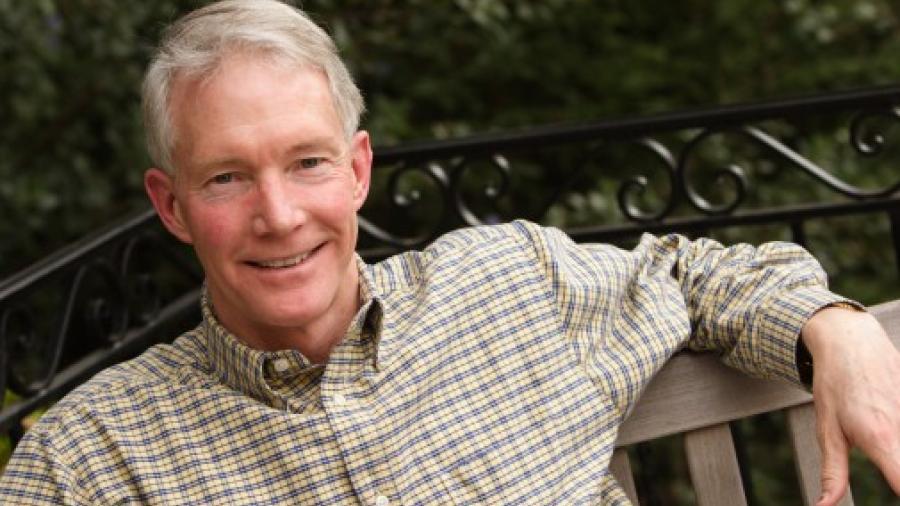Westmont Magazine Seeing Mathematics Through the Eyes of Faith

Professor Russ Howell has Co-edited a New Book Examining Connections Between Mathematics and Faith
Russ Howell always thought the HarperOne series Through the Eyes of Faith should include a volume on mathematics. The initial set featured seven disciplines: biology, business, history, literature, music,psychology and sociology. When Russ learned the publisher planned to produce second editions of these works, he proposed adding a volume in his subject area and solicited help in writing it. At a 2009 Association of Christians in the Mathematical Sciences (ACMS) meeting, Russ co-led a writing workshop to tackle the project.“We hammered out the contents of the book and assigned authors to the individual chapters,” Russ says.
Then began the challenge of convincing HarperOne to adopt the work. Not only did Russ submit a prospectus, but he surveyed schools in the Council of Christian Colleges and Universities to learn how many professors would assign the book in their classes. These efforts paid off. “We’re pleased that the discipline of mathematics now has a place in the series,” Russ says.
In all, 10 mathematicians contributed to “Mathematics Through the Eyes of Faith” (HarperOne, 2011). Jim Bradley, a mathematics professor at Calvin College, co-edited the book with Russ, and both scholars contributed chapters. Westmont faculty also assisted. Mathematics professor Ray Rosentrater co-authored two chapters, and philosophy professor David Vander Laan read the manuscript as the philosophical consultant. Another mathematician, Patti Hunter, evaluated the chapter on the history of mathematics and faith. Art professor Lisa DeBoer reviewed the chapter on beauty.
In 2011, ACMS held its 18th biennial meeting at Westmont. Ninety people attended from all over the United States, Canada and Romania, and one of the sessions featured the new book. Russ coordinated the conference with help from Rosentrater and three mathematics majors, Elizabeth Grossman, Ricky Lopez and Daniel Ray. Russ edited the 200-page conference proceedings.
Russ and Jim Bradley worked together on an earlier book, “Mathematics in a Postmodern Age: A Christian Perspective,” which also grew out of an ACMS session. At a 1997 meeting, Russ critiqued a book presenting a combative Christian perspective on mathematics, which he found embarrassing. He challenged scholars at the conference to work together on a volume that better expressed the views of Christian mathematicians and asked if anyone wanted to help. Bradley knocked on his hotel door that evening, and their collaboration began. They applied for a grant and recruited writers, producing “Mathematics in a Postmodern Age” in 2001.
College students in a variety of disciplines can read these two books. But Russ co-wrote “Complex Analysis for Mathematics and Engineering,” a textbook in its sixth edition, just for upper-division mathematics majors. Widely used on college campuses, the book represents a traditional approach to the subject. But Russ believes his discipline needs to reform the way it teaches complex analysis.“Why do we need to understand complex analysis when computers perform calculations so well?” he asks. He wants to gather a group of mathematicians at Westmont to discuss the best way to approach this subject in the 21st century. When the scholars have completed their work, he’ll write an entirely new text.
Russ contemplates another project. In 1734, Bishop George Berkeley wrote “The Analyst: A Discourse Addressed to an Infidel Mathematician” attacking Isaac Newton and Gottfried Leibniz and their theories of infinitesimal calculus. Annoyed that his contemporaries accused religious people of sloppy thinking, he pointed out the fallacies in the work of mathematicians, and his criticisms have proven valid. Russ is interested in producing an annotated edition of “The Analyst” to examine Berkeley’s arguments.
Russ contends that mathematicians ask big questions just like scholars in the humanities, and “Mathematics Through the Eyes of Faith” addresses 10 such issues. For centuries, mathematicians acknowledged the connection between their discipline and religious faith until David Hilbert argued in the 20th century that mathematics means nothing, it’s just playing around with symbols. Russ notes that mathematicians don’t act like they believe their discipline is meaningless. “What explains the effectiveness of mathematics?” he asks. “Why should formulas be both beautiful and useful? It’s especially important for scholars at Christian colleges to explore the connections between mathematics and faith.”